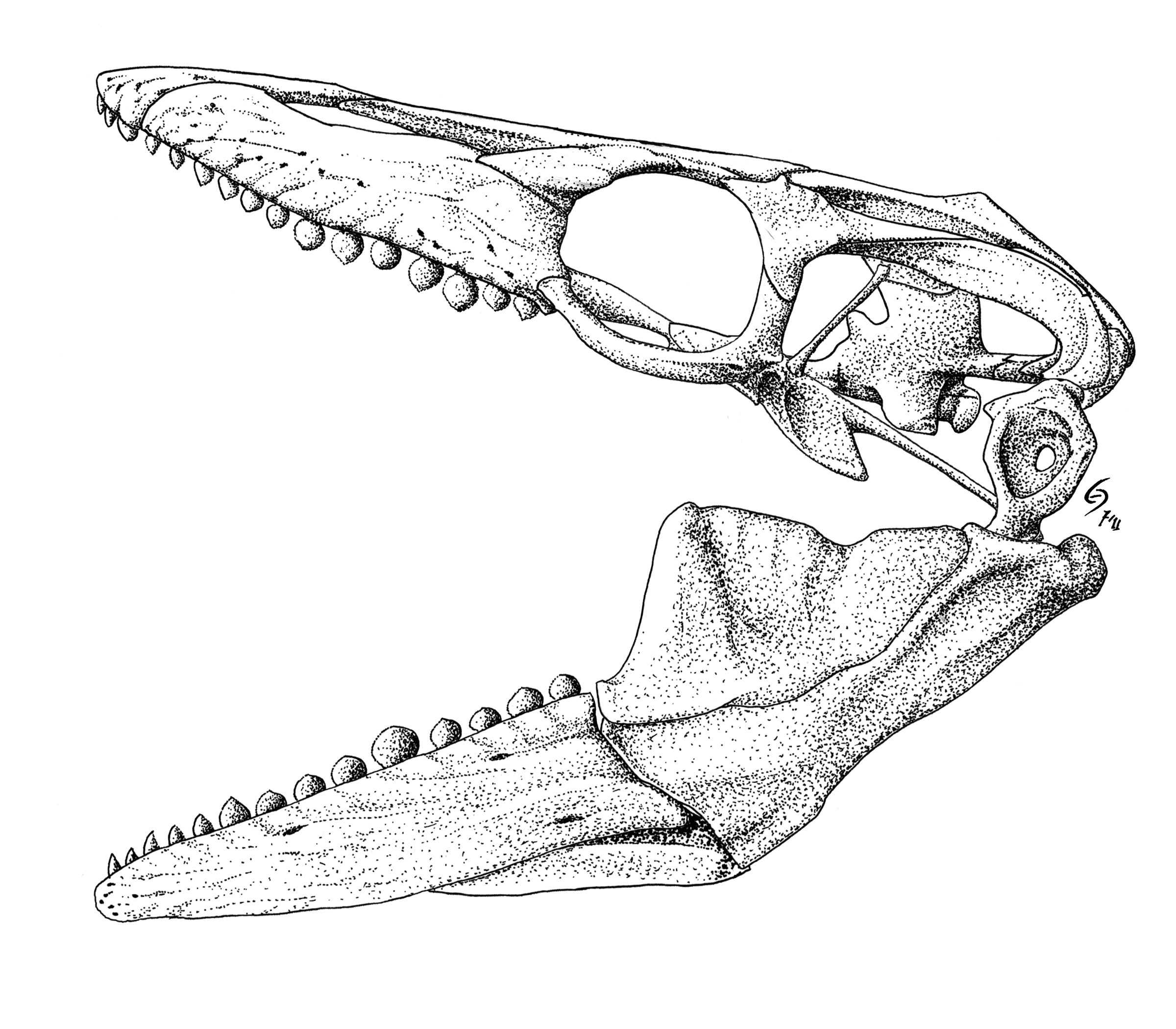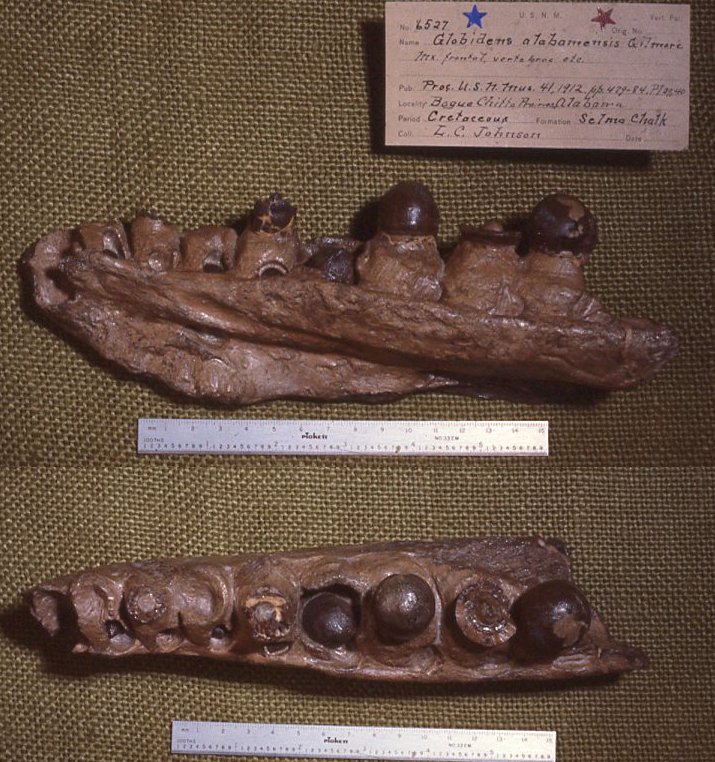|
Eremiasaurus
''Eremiasaurus'' is a genus of extinct genus of Cretaceous marine lizard belonging to the mosasaur family. It is classified as part of the Mosasaurini tribe (within the Mosasaurinae) and is exclusively known from the Maastrichtian phosphates of the Ouled Abdoun Basin in Morocco. ''Eremiasaurus'' means "desert lizard", referring to the arid climate of present-day Morocco where its fossils were recovered. One species is known, ''E. heterodontus'', whose specific name refers to high degree of heterodonty exhibited compared to other species of mosasaur. It was a medium-sized mosasaur, with the largest specimen measuring around in length. Description ''Eremaiasaurus'' is known from two specimens UALVP 51744 and OCP DEK/GE 112, both designated as syntype specimens due to the fact that UALVP 51744 lacks precise locality data. The syntype specimen UALVP 51744 belongs to an individual about long, consisting of a nearly complete skull, vertebral column and isolated pieces of the append ... [...More Info...] [...Related Items...] OR: [Wikipedia] [Google] [Baidu] |
Mosasaurus
''Mosasaurus'' (; "lizard of the Meuse River") is the type genus (defining example) of the mosasaurs, an extinct group of aquatic squamate reptiles. It lived from about 82 to 66 million years ago during the Campanian and Maastrichtian stages of the Late Cretaceous. The earliest fossils of ''Mosasaurus'' known to science were found as skulls in a chalk quarry near the Dutch city of Maastricht in the late 18th century, which were initially thought to have been the bones of crocodiles or whales. One skull discovered around 1780, and which was seized by France during the French Revolutionary Wars for its scientific value, was famously nicknamed the "great animal of Maastricht". In 1808, naturalist Georges Cuvier concluded that it belonged to a giant marine lizard with similarities to monitor lizards but otherwise unlike any known living animal. This concept was revolutionary at the time and helped support the then-developing ideas of extinction. Cuvier did not designate a scienti ... [...More Info...] [...Related Items...] OR: [Wikipedia] [Google] [Baidu] |
Prognathodon Lutugini
''Prognathodon'' is an extinct genus of marine lizard belonging to the mosasaur family. It is classified as part of the Mosasaurinae subfamily, alongside genera like ''Mosasaurus'' and ''Clidastes''. ''Prognathodon'' has been recovered from deposits ranging in age from the Campanian to the Maastrichtian in the Middle East, Europe, New Zealand, and North America. ''Prognathodon'' means "forejaw tooth", which originates from the Latin ''pro''- ("earlier" or "prior"), Greek ''gnathos'' ("jaw") and ''odṓn'' ("tooth"). Twelve nominal species of ''Prognathodon'' are recognised, from North America, northern and western Africa, the Middle East, western Europe and New Zealand. Due to the sometimes clear differences between them and the incomplete nature of many of the specimens, the systematics of the genus and which species should properly be considered ''Prognathodon'' is controversial. Some species have been assigned to other genera, such as ''Dollosaurus'' and ''Brachysaurana'', but ... [...More Info...] [...Related Items...] OR: [Wikipedia] [Google] [Baidu] |
Prognathodon Saturator
''Prognathodon'' is an extinct genus of marine lizard belonging to the mosasaur family. It is classified as part of the Mosasaurinae subfamily, alongside genera like '' Mosasaurus'' and '' Clidastes''. ''Prognathodon'' has been recovered from deposits ranging in age from the Campanian to the Maastrichtian in the Middle East, Europe, New Zealand, and North America. ''Prognathodon'' means "forejaw tooth", which originates from the Latin ''pro''- ("earlier" or "prior"), Greek ''gnathos'' ("jaw") and ''odṓn'' ("tooth"). Twelve nominal species of ''Prognathodon'' are recognised, from North America, northern and western Africa, the Middle East, western Europe and New Zealand. Due to the sometimes clear differences between them and the incomplete nature of many of the specimens, the systematics of the genus and which species should properly be considered ''Prognathodon'' is controversial. Some species have been assigned to other genera, such as ''Dollosaurus'' and ''Brachysaurana' ... [...More Info...] [...Related Items...] OR: [Wikipedia] [Google] [Baidu] |
Mosasaurini
Mosasaurini is a extinct Tribe (biology), tribe of Mosasaurinae, mosasaurine mosasaurs who lived during the Late Cretaceous and whose fossils have been found in North America, South America, Europe, Africa and Oceania, with questionable occurrences in Asia. They are highly derived mosasaurs, containing genera like ''Plotosaurus'', having unique adaptations to fast swimming speeds, or ''Mosasaurus'', which is among the largest known marine reptiles. Description The Mosasaurini form a clade of derived Mosasaurinae, mosasaurine. The Tribe (biology), tribe contains one of the largest known mosasaur species, ''Mosasaurus, Mosasaurus hoffmannii'', measuring over in length, but such a size is unusual within the tribe and even within the genus ''Mosasaurus'' in himself. Other large representatives are around long (like ''Plotosaurus'', ''Eremiasaurus'', ''Mosasaurus conodon'' and ''Mosasaurus beaugei'') while others are even smaller, in a range of around long (like ''Mosasaurus miss ... [...More Info...] [...Related Items...] OR: [Wikipedia] [Google] [Baidu] |
Prognathodon
''Prognathodon'' is an extinct genus of marine lizard belonging to the mosasaur family. It is classified as part of the Mosasaurinae subfamily, alongside genera like ''Mosasaurus'' and '' Clidastes''. ''Prognathodon'' has been recovered from deposits ranging in age from the Campanian to the Maastrichtian in the Middle East, Europe, New Zealand, and North America. ''Prognathodon'' means "forejaw tooth", which originates from the Latin ''pro''- ("earlier" or "prior"), Greek ''gnathos'' ("jaw") and ''odṓn'' ("tooth"). Twelve nominal species of ''Prognathodon'' are recognised, from North America, northern and western Africa, the Middle East, western Europe and New Zealand. Due to the sometimes clear differences between them and the incomplete nature of many of the specimens, the systematics of the genus and which species should properly be considered ''Prognathodon'' is controversial. Some species have been assigned to other genera, such as ''Dollosaurus'' and ''Brachysaurana'', ... [...More Info...] [...Related Items...] OR: [Wikipedia] [Google] [Baidu] |
Prognathodon Waiparaensis
''Prognathodon'' is an extinct genus of marine lizard belonging to the mosasaur family. It is classified as part of the Mosasaurinae subfamily, alongside genera like ''Mosasaurus'' and ''Clidastes''. ''Prognathodon'' has been recovered from deposits ranging in age from the Campanian to the Maastrichtian in the Middle East, Europe, New Zealand, and North America. ''Prognathodon'' means "forejaw tooth", which originates from the Latin ''pro''- ("earlier" or "prior"), Greek ''gnathos'' ("jaw") and ''odṓn'' ("tooth"). Twelve nominal species of ''Prognathodon'' are recognised, from North America, northern and western Africa, the Middle East, western Europe and New Zealand. Due to the sometimes clear differences between them and the incomplete nature of many of the specimens, the systematics of the genus and which species should properly be considered ''Prognathodon'' is controversial. Some species have been assigned to other genera, such as ''Dollosaurus'' and ''Brachysaurana'', but ... [...More Info...] [...Related Items...] OR: [Wikipedia] [Google] [Baidu] |
Prognathodon Rapax
''Prognathodon'' is an extinct genus of marine lizard belonging to the mosasaur family. It is classified as part of the Mosasaurinae subfamily, alongside genera like ''Mosasaurus'' and ''Clidastes''. ''Prognathodon'' has been recovered from deposits ranging in age from the Campanian to the Maastrichtian in the Middle East, Europe, New Zealand, and North America. ''Prognathodon'' means "forejaw tooth", which originates from the Latin ''pro''- ("earlier" or "prior"), Greek ''gnathos'' ("jaw") and ''odṓn'' ("tooth"). Twelve nominal species of ''Prognathodon'' are recognised, from North America, northern and western Africa, the Middle East, western Europe and New Zealand. Due to the sometimes clear differences between them and the incomplete nature of many of the specimens, the systematics of the genus and which species should properly be considered ''Prognathodon'' is controversial. Some species have been assigned to other genera, such as ''Dollosaurus'' and ''Brachysaurana'', ... [...More Info...] [...Related Items...] OR: [Wikipedia] [Google] [Baidu] |
Globidens Dakotensis
''Globidens'' ("Globe teeth") is an extinct genus of mosasaur lizard classified as part of the Globidensini tribe in the Mosasaurinae subfamily. ''Globidens alabamaensis'' was the first species of ''Globidens'' described, in a publication by Charles W. Gilmore (1912). It is used as the type specimen for ''Globidens''. ''Globidens'' belongs to the family Mosasauridae, which consists of several genera of predatory marine reptiles prevalent during the Late Cretaceous. Specimens of ''Globidens'' have been discovered in Syria, North America, Morocco, Angola, and Indonesia. Among mosasaurs, ''Globidens'' is probably most well known for its highly rounded, globe-like teeth. Description ''Globidens'' was a relatively medium sized mosasaur, measuring long and weighing . It was similar in appearance to other mosasaurs (streamlined body with flippers, a laterally flattened tail and powerful jaws). The teeth of ''Globidens'' differed from those of other mosasaurs in being globular, g ... [...More Info...] [...Related Items...] OR: [Wikipedia] [Google] [Baidu] |
Globidens Alabamaensis
''Globidens'' ("Globe teeth") is an extinct genus of mosasaur lizard classified as part of the Globidensini tribe in the Mosasaurinae subfamily. ''Globidens alabamaensis'' was the first species of ''Globidens'' described, in a publication by Charles W. Gilmore (1912). It is used as the Type (biology), type specimen for ''Globidens''. ''Globidens'' belongs to the family Mosasauridae, which consists of several genera of predatory marine reptiles prevalent during the Late Cretaceous. Specimens of ''Globidens'' have been discovered in Syria, North America, Morocco, Angola, and Indonesia. Among mosasaurs, ''Globidens'' is probably most well known for its highly rounded, globe-like teeth. Description ''Globidens'' was a relatively medium sized mosasaur, measuring long and weighing . It was similar in appearance to other mosasaurs (streamlined body with flipper (anatomy), flippers, a laterally flattened tail and powerful jaws). The teeth of ''Globidens'' differed from those of other ... [...More Info...] [...Related Items...] OR: [Wikipedia] [Google] [Baidu] |






